Introduction
After playing lots of the Oblivion Remaster, I’ve found myself in a very Bethesda-ey mood and since I’ve already replayed Morrowind recently and can only be motivated to play Skyrim, Fallout 3 or Fallout 4 via threat of deadly force, I finally decided to purchase Starfield.
You’ll notice that the game came out close to 2 years ago now and has fallen out of the headlines for a bit and that’s exactly why I’ve waited for so long. Starfield is an Xbox and PC exclusive but is also Bethesda’s first new intellectual property since before I was born, so its release became a resonance cascade of aggrieved PlayStation owners annoyed that they couldn’t play it, hardcore Bethesda fans expecting the world and Bethesda’s marketing appealing to both fans of space exploration sims like Elite: Dangerous and to its traditional player-base but not satisfying either fully. Combined with a stupid controversy about the character creator options, this all brewed up a perfect storm that allowed the discourse around the game to become pretty vitriolic, so I decided to wait until the dust had settled and I had zero preconceptions left.
I was willing to give Starfield a chance because I absolutely adore science fiction, it’s my favourite genre by miles. I’ve been writing sci-fi stories since I was 12 years old (one day, I might start another publication to write them but that’s a whole process in itself) and I’ve watched more hours of Star Trek than there are stars in the night sky; I also love pre-Disney Star Wars. So you could say I was predisposed to trying the game at some point.
I’ll be reviewing Starfield in a bid to discover if I enjoy it, if it is objectively a well-made video game, if I think it appeals to Bethesda newcomers and ultimately, if it deserves its spotty reputation.
I played the game on PC at the Ultra settings pre-set using an RTX 5070 and an i7 12700KF, all screenshots captured are my own and I purchased the game for about £32.
A Rocky Start
This is going to come off really nit-picky but my first problem with Starfield came when I reached the main menu.
This is a really evocative, clean and atmospheric main menu; it reminds me a little bit of Alien: Isolation. It has some thematic sounds when you scroll through options, clearly labelled items, pleasant ambient music composed by Inon Zur, and the image is a pleasing portent for deep space adventure.
And they slapped a big, fat advert for Oblivion in the top right corner. For fuck’s sake, Bethesda!
The rocky start wasn’t at an end here.
Let’s cast our minds back to the openings of some of Bethesda’s other popular RPG’s for a moment. Skyrim begins with the player bound and gagged in a cart, being transported to Helgen for execution and we learn a lot about the world and story from this introduction. We witness the Empire’s moral and political decay in real time as we share our prison cart with rebels, the esteemed General Tullius takes orders from a Thalmor: an agent of a foreign power and the Imperial Legion execute a thief and then attempt to execute the player for no good reason. In Fallout 4: a game I don’t even like that much I’ll add, we get a glimpse of our protagonist’s idyllic life in the American suburb, with white picket fences, a well-stocked fridge and a loving wife and child before nuclear hellfire arrives and we are forced underground and into cryo-sleep. It doesn’t set up a particularly strong narrative but it is visually striking and hooks the player.
In Starfield, the first 10 minutes of the game are spent waltzing through shit-brown, rocky mining tunnels while a boring character you don’t see again for ages talks at you, then you stop for 5 seconds to mine some stone before discovering the McGuffin that sets off the main plot. Bethesda then attempts a big world reveal moment once you step outside: like stepping out of the sewers in Oblivion or out of the vault in Fallout 4, except it falls completely flat because the starting planet is dry as dust and they barely give you a minute to take in your surroundings before more dialogue and a ham-fisted action set-piece.
Saved by the Board
At this point, alarm bells were already ringing.
The brief flash of combat I’d gotten to play had been enjoyable, the game looked and ran well up to that point and I was enjoying the ‘NASA-Punk’ aesthetic along with the gentle-handed approach to ambient music, but nothing so far had been… exciting. No rush of adrenaline like Helgen’s dragon attack, no plot hook like the beginning of Fallout 4, no exciting quest setup either; I got the McGuffin, was handed a multi-billion dollar ship and a robot for free and told to go and deliver it. I was internally groaning as I trudged my way up the vessel’s loading ramp, rifling my sticky fingers through the cargo bay’s pharmacy-green medicine boxes for supplies and taking a last fleeting look outside before I’d be crammed into a cockpit for the next half an hour of gameplay to be talked at again.
But that’s not what happened.
I stepped aboard my modest vessel: the Frontier, Inon Zur’s soundtrack began to whisper through my headphones and I started to have flashbacks of space adventures past: of hunting down Star Maps across the galaxy in the Ebon Hawk, of building an interstellar army in the Normandy and of a million bounties won and lost in Elite: Dangerous. You see, in Starfield, the followers you encounter each have a set of skills and can be assigned to your ship as crew; unlike a lot of space games, you can walk around your ship freely as well, you aren’t super-glued to your pilot’s seat. The crew will mulch around the hold tapping on consoles, chatting at the table and greeting you as you walk by; I’m a Star Trek fan and Starfield had just given me the opportunity to have my own cast of characters on the bridge… perfect.
And it gets better.
Starfield has a complete ship building system: you can name it, you can colour it, you can choose where all the little bits go and upgrade them, I was over the moon when I found out.
Aggress to Impress
The one thing that’s stuck out to me most so far playing Starfield is just how good the combat is compared to Bethesda’s other RPG’s.
The guns in this game all have suitably destructive sound effects, energy weapons crackle and spark through the air, conventional firearms snap the sound barrier and even suppressed weapons spit out rounds with a satisfying thump. Explosions rattle your surroundings, knives and swords give off the familiar video-gamey ‘shink’ as you slice through targets and the ability to set enemies on fire, poison them and even explode their boost packs means you can subject your foes to some truly unenviable fates.
I often don’t use energy weapons in sci-fi games because they tend to be just so damn unsatisfying but in Starfield they feel absolutely deadly and I have to commend that.
The punchy combat is haunted by the usual Bethesda issues such as their ‘unique’ approach to difficulty scaling, dumb AI and what I like to call the Destiny Effect: most encounters boiling down to putting scores of rounds into a big armour target while you watch their little health-bar diminish with nothing to spice up the gameplay but the sponginess is nowhere near as bad as can be found in Oblivion or Skyrim.
Diseases, injuries and other status effects are depicted better than they ever have been here too, I accidentally inhaled a big cloud of chlorine gas while tracking a bounty and my game turned into Metal Gear Solid 4 until I could get emergency surgery for my lung damage.
Supporting all this is the return of my favourite feature from Fallout 4: gunsmithing. I didn’t even like that game much but the ability to make your own guns essentially from the ground up was addictive, fun and is a welcome addition to Starfield; I haven’t built up the supplies or expertise necessary to get fully stuck in yet but already I have forged a burst fire, high calibre pistol that could stop a rhino in moments.
Your move, creep!
Vexing Visuals
Starfield is an aesthetically pleasing game but not a particularly impressive one as far as graphics are concerned.
At times, its grand vistas can look extremely picturesque and the game even throws in a photo mode: generally a sign that the developers know how good the world (or worlds in this case) look and under the right conditions, Starfield certainly does look top notch for 2023.
However, there are also times, particularly under mottled lighting or heavy shadow, that Starfield honestly begins to look like 2015’s Fallout 4 and the graphics are so inconsistent I’ve actually had to stop and check a few times during play that my settings hadn’t somehow been lowered.
Maybe I’m just picky but to me? These almost look like 2 different games. I’m not sure why some areas look spectacular but others look absolutely awful, like a mid-2010’s Xbox One game.
Graphics aren’t everything, but contrary to what some people say, they absolutely do matter; a good game should be a feast for the senses: it should look stunning, sound great, gameplay should feel so smooth and responsive that the actions the player can take become instinctual and like all art, a fantastic game needs to be emotive or thought-provoking but when graphics are this inconsistent, all of that is at risk.
Role the Dice
Setting aside all the surrounding mechanics for a moment, I want to talk about the role-playing in Starfield. To what extent can you be the character you want to be? How much of the game revolves solely around the player? Are we treated like a person or like a tool? These were all questions I had going into Starfield.
There has been an annoying trend in Bethesda games since around the time of Oblivion where the player ends up, for lack of a better description, as The Most Interesting Man/Woman in the World. Every guild or faction the player joins, they eventually get to run, every conflict the player intervenes in is decided solely by their actions and the player’s role in the story is predefined by some kind of prophesy or special power like Skyrim’s protagonist being Dragonborn or the Emperor prophesising your future in Oblivion. Fallout 4 took all this a step further and gave our character a voice, family baggage and a dialogue wheel, reducing the role-playing to such an extent where the player only had control over World’s Greatest Dad’s current allegiance and abode.
I’m very glad to say that Starfield is actually a massive improvement in this department.
WARNING: Faction Questline Spoilers, Skip Ahead or Suffer
I’m a member of 2 factions so far: the Trackers Alliance and Ryujin Industries. The former faction’s opening quest was an extremely refreshing experience and gave me a bit of a smile because for once… you balls the whole thing up!
This quest has you arrest an informant who leads you to a notorious criminal: Hannibal, who runs a secret ‘chop-shop’ space station where he deconstructs and refits stolen star ships to sell for a profit. You and a buddy are dispatched by the enigmatic head of the faction: No. 1 (read as ‘No-one’) to apprehend the slippery bastard and to prove you’ve got what it takes to be a Tracker. After a pretty gruelling, zero-gravity firefight through the space station which culminates in you blasting a hole through a bulkhead using a ship’s cannon, you discover that that you had the real Hannibal aboard your ship all along; he was no informant and you get to watch as he takes off in your sheep, leaving you to limp home, tail between your legs in a half-built rust bucket to report your failure.
Of course, you still get let in to the guild but from then on you mostly just take bounties from a mission board where you can take on crooks all over the galaxy wanted dead or alive, a lot of players were annoyed the Trackers have no real quest line but to be honest, it’s been refreshing to just be a grunt again in a Bethesda game, it takes me back to Morrowind. You just get to come back to a sick hideout and chat with your fellow bounty hunters and get greeted by some random NPC’s differently as you gain notoriety, I like it.
You’re not the chosen one, you’re not Jesus Christ, you’re not the droids we’ve been looking for, you’re not Locutus of Borg, you’re not Lucas Skinwalker, you’re whoever you want to be, as long as you put a hole through some scumbag’s head when he gets put on that mission board. Even the main quest is particularly hands-off, recruiting you into a faction of misfits who’s only unified goal is to collect artefacts, the characters kind of indirectly tell you they don’t care what you do outside of this goal either, you have no real role assigned to you other than being a member of this loose collective.
After an unsuccessful start to my illustrious career and realising the freedom Starfield grants, I began to engage in that delicious kind of roleplay that’s been long-missing since Morrowind, the kind where your playstyle and path through the game dictates your entire character. So far, I’d stumbled into a stealth-playstyle, armed with a nasty combat knife, an expensive burst-fire pistol and an ‘Old World Hunting Rifle’ (actually a VSS Russian Special Forces sniper rifle.. what were they hunting with this thing?) The ammo for these weapons is somewhat rare and expensive, meaning I have to make every shot count, wasting it on civilians or the undeserving wouldn’t do… and my character started to take shape: an assassin with a flair for the old fashioned, happy to take the lives of murderers and criminals but respecting of fellow trackers, mercenaries and merciful to the non-professional life-taker.
My character is a professional killer, his loyalties lie with the highest bidder but he’s no criminal and no coward and the Ryujin Industries quest line was absolutely wonderful to play this role in.
It opens with you being given a job in the office and then sent on a literal coffee run when a former, disgruntled employee pulls a gun on you; you stole his dream, it was him who was going to climb the ladder at Ryujin! I hit him with the Thanos “I don’t even know you.” And in the spirit of my character, I started to talk him down out of a fight; I only shoot professionals, not disgruntled desk clerks. To cut a long story short, it worked and the troubled young man disappeared into the streets of Neon while I was reassigned to the ‘Operative’ role at Ryujin: a not so subtle by-word for corporate espionage and deniable ops.
To cut a very long story short, I enjoyed every damn minute of this quest line and playing my character in it.
My role as a corporate spy took me on such jobs as sabotaging a shipyard so that a worker fatality would lead to massive negligence charges, helping an informant deal with an assassin in exchange for incriminating information, rooting out a mole at the company’s highest levels and the climax of the questline: infiltrating the skyscraper HQ of a rival corporation: either via a Bond-esque disguise or rooftop insertion to recover a prototype mind control chip and to hack sensitive information about the company’s ties to the criminal world from their computers. All the while, after every mission, I got to return to HQ and have conversations akin to the M’s Office scenes in a Bond film, I would call out the corporate bullshit, give cocky answers and break protocol and regularly received a bollocking if I decided to kill a character based on my fictional protagonist’s moral code or ‘liquidated’ assets to the corporation if I found them slimy or to be hurting innocents. At the start of the quest line, my character’s cold confidence and dismissive attitude was scolded and scoffed at but by the end? The characters believed what I said and had every confidence in my skills, it was a very satisfying arc.
This would have been satisfying enough but without fail, I found my actions would always be acknowledged in the game’s writing and that the player was given agency at every turn, right up to the epilogue of the quest where, augmented with the only mind control chip in existence, I had to lobby the board either to roll out the technology to the public or to keep it locked in a dark cupboard forever. I chose the latter and had a big grin on my face when I got to turn around in the end and tell the CEO that the ease with which I got the money-hungry, morally bankrupt board to vote for the technology’s mothballing is exactly why nobody should ever hold that power.
My companion, Andreja, even reacted to the situation, expressing apprehension at my newfound ‘ability’ (controlling characters with the device has become a permanent tool in my arsenal even after the questline) while agreeing that if one person should wield that power, better me with my dubious moral code.
To top it off, I didn’t end up the CEO, I just got a new office and a mission board for repeatable stealth quests, phew.
SPOILERS END HERE
I’ve not even gotten into the traits you can pick at the start of your playthrough or the time I discovered doctors can perform experimental surgery to augment my muscles’ weakness to planetary gravity based off one of these traits I picked, the point is, I think this is the best Bethesda game for pure roleplaying since Morrowind and I’ve loved shaping this character and the stories I’ve made along the way with creative interpretations of my objectives and the many quests with multiple outcomes.
A meeting with the CEO, wearing an expensive, fitted suit, all company-funded.
Bits and Bobs
Here are some of my final little thoughts on the game: little nit-picks and little things I like, before we get around to the big question.
Ship combat is rare but you can board enemy ships and fit your vessel with a plethora of weapons, the complexity and mechanics are more in-depth than No Man’s Sky but less so than Elite: Dangerous
The main questline is mind-numbingly boring as are most of the companions, I advise you stop following it the moment you hit ‘Into the Unknown’ and then pick it back up once you have a feel for the game or want to unlock new crew, it does spoon-feed you some gameplay altering abilities but rhey’re not essential
The polish is surprisingly high for a Bethesda game, I’ve encountered just a few physics glitches, one moment where Andreja started Usain Bolting it into a wall but no crashes so far
Side-quests tend to be short but often thought-provoking in a way that most other Bethesda games are not, a particular highlight was when I had to play diplomat for a generation ship which arrived at a world… only to find out it had already been colonised as FTL travel was perfected after they’d already left Earth
Shooting is sometimes ruined by hit-detection issues and some railings being weirdly difficult to fire through
The levelling system works on challenges where you need to hit a certain amount of stealth attacks, healing items used etc. to unlock the next level of a skill, which you can then acquire with a Skill Point earned at each level up, I really like it and it encourages you to actually play your build, though the Skyrim issue of ending up the everything-man still exists
Modding support is in a turbulent place at the moment but Bethesda’s (paid) creation club support is quite robust and I could see myself picking up 1 or 2 mods there
The UI and especially the maps are really painful at first but not too bad once you get used to them
The game does little to teach the player about its world. Each faction is quite distinct in their character and governance but I didn’t learn than that United Colonies and the Freestar Collective had recently fought a war until almost 25 hours in, that’s pretty essential worldbuilding just… not told. I also have no clue why Earth is a barren wasteland in this game
Yikes.
The Big Question
So, should you buy Starfield?
It feels to me like the vitriol around this game never really went away. Shortly after buying, I checked the subreddit of the game to gauge general opinions and under every positive post there were comments with hundreds of likes mourning the game’s ‘failure’ and what it ‘should’ have been. Official support hasn’t even ended yet.
Starfield is one of those games the internet says you’re not allowed to like.
“Play Cyberpunk or KCD2.” I’ve read. “Playing Fallout 4 made me realise how boring Starfield is.” That last one is particularly funny to me, as I’m sure most of you remember, Fallout 4 really was the Starfield of its day and was widely rejected by Fallout fans. Well, I played Fallout 4 and the first Kingdom Come: Deliverance on release, I’ve also played Cyberpunk and I like Starfield better than all of those games, but I’m coming at this game from a different angle than I imagine most did. I’m far removed from the hype, didn’t really follow the marketing and am more than happy to let most releases pass me by for a year or two before I pick them up.
Starfield appeals to both Bethesda fans and fans of the much more niche space-sim genre. I started playing Elite: Dangerous all the way back in 2014 and played pretty much every week from 2015-2019 with some breaks here and there and I’ve been playing No Man’s Sky on and off since 2019; this is a genre I’m quite familiar with.
Elite: Dangerous is a game that’s been mismanaged to death. It took them 7 years to add the ability to get up out of your ship and walk about on stations, it has received less than 10 new ships in 10 years and the game’s ‘impending’ alien invasion took almost a real-life decade to actually happen, long after most of the player base had left.
No Man’s Sky is as wide as an ocean and as deep as a puddle. You explore endless procedurally generated galaxies grinding for resources, building outposts, scanning and doing missions that amount to more currency and resources.
I am so, so tired of what the rest of this genre provides. I just want to have fun, I don’t want to spend real life days ferrying cargo as an interstellar FedEx van in Elite, I don’t want to scan endless generated slop in No Man’s Sky, I want to go on adventures, I want to fight battles, go on real quests and visit locations that aren’t exactly the same as somewhere else. You can certainly do those other things in Starfield but they aren’t the main appeal of the game, which is a breath of fresh air to me.
Starfield provides everything I want from the space-sim genre combined with some of the best bits of Bethesda’s game design.
As a Bethesda RPG? It’s a slightly better Fallout 4 with all the settlement building crap made optional and without Preston Garvey’s incessant nagging. As a space-sim/exploration game? I know people felt cheated by the marketing, the exploration isn’t amazing and most planets are very boring in Starfield but to be completely honest, the appeal of exploring a procedurally generated universe has long passed for me, so while I sympathise with those who wanted something different, the fact that Starfield is ‘just’ a Bethesda RPG in space with the procedural stuff mostly being in uncharted space or limited to the outskirts of settlements is more than enough for me. In Starfield I can avoid the parts of the game that bore me, the generous fast travel system allows me to skip the tedium of repeated fuel runs and slow landing-sequences and unlike Elite, it’s not a game that relies on using community-made sites when doing something as simple as buying the ship you want or upgrading your autocannons.
I think you should try Starfield. It’s not a 10/10, it’s not The Elder Scrolls in space and it’s probably not going to be remembered well but I find the game to be quite overhated and when the next expansion releases later in the year, or perhaps with a future sequel, I hope Bethesda can turn this into a proper, prestigious franchise.
Asset termination, corporate liquidation and holistic law enforcement, all available at a price.
I hope you enjoyed my first review in quite a long time.
I’d be very interested to hear some feedback in the comments. I find my own writing to be too wordy and my aversion to numbers-based scoring to not fit what most people are looking for in a review; there is also the issue that I don’t play whatever’s current and trendy most of the time and that Substack already has dozens of reviewers.
I decided to review Starfield because I’ve literally never heard a positive word on this game outside of its own subreddit and I don’t feel it’s fair.
So, more reviews? Stick to the usual stuff? Less wordy? I’d be interested to hear your thoughts below.





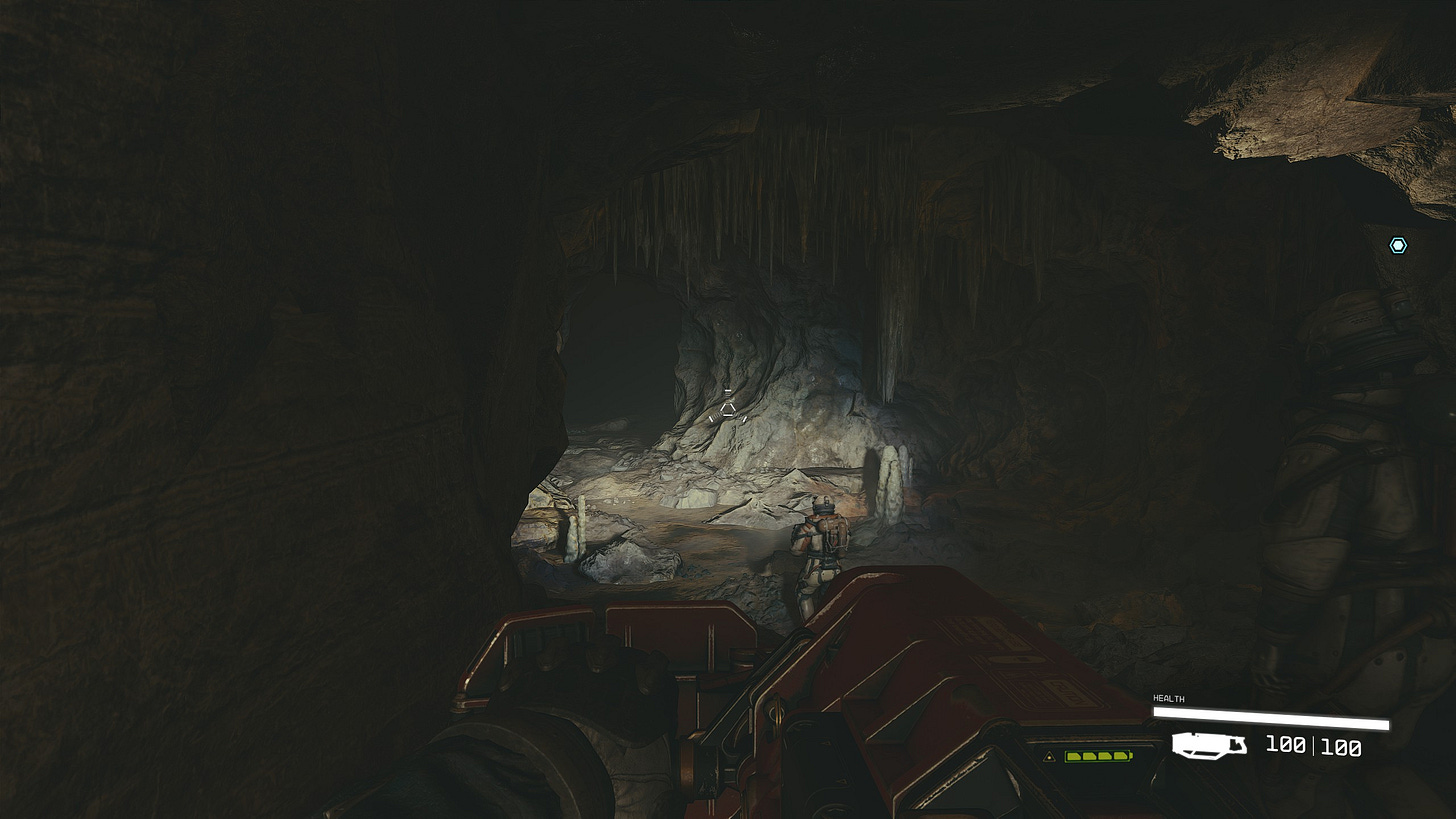
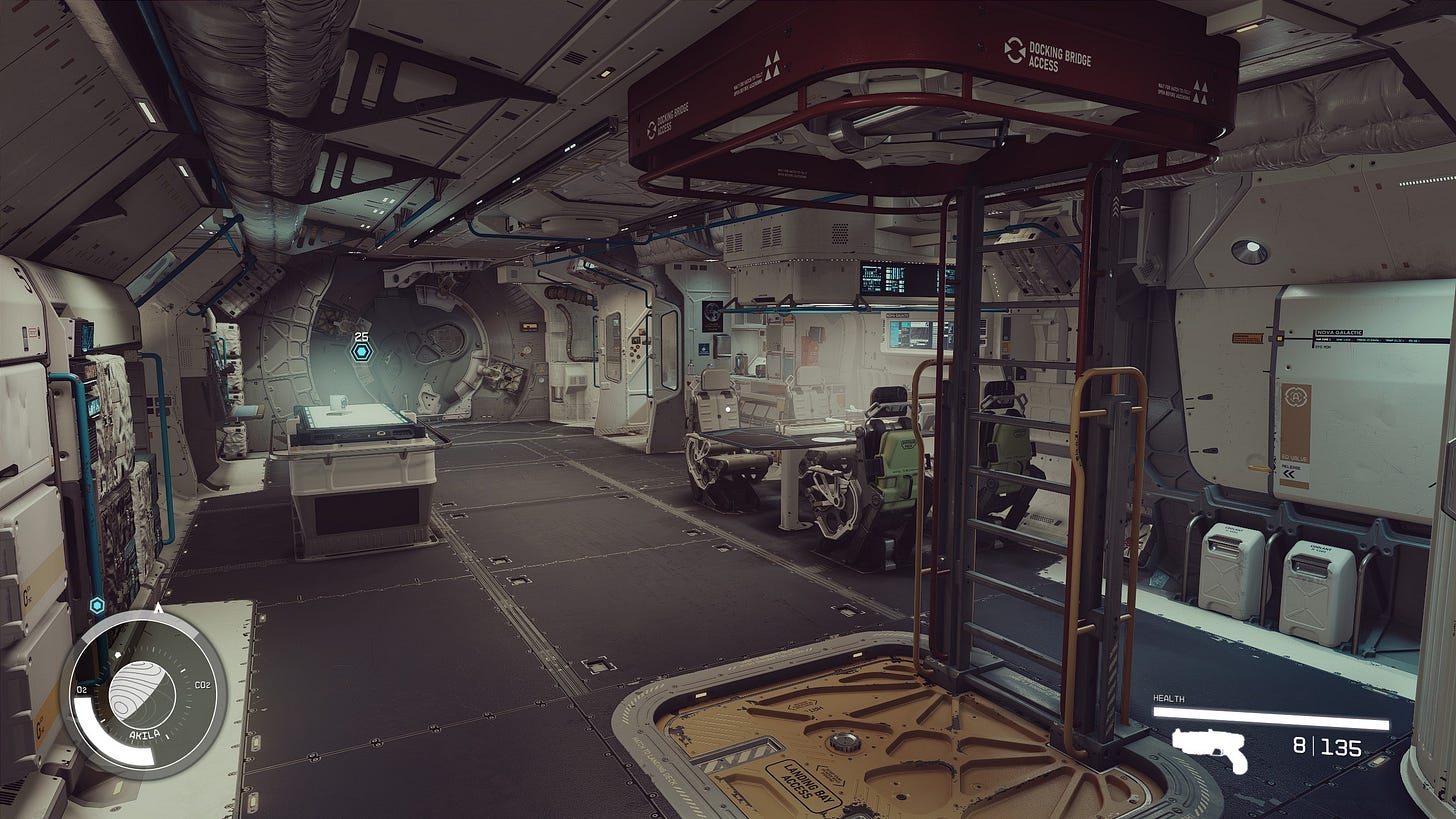

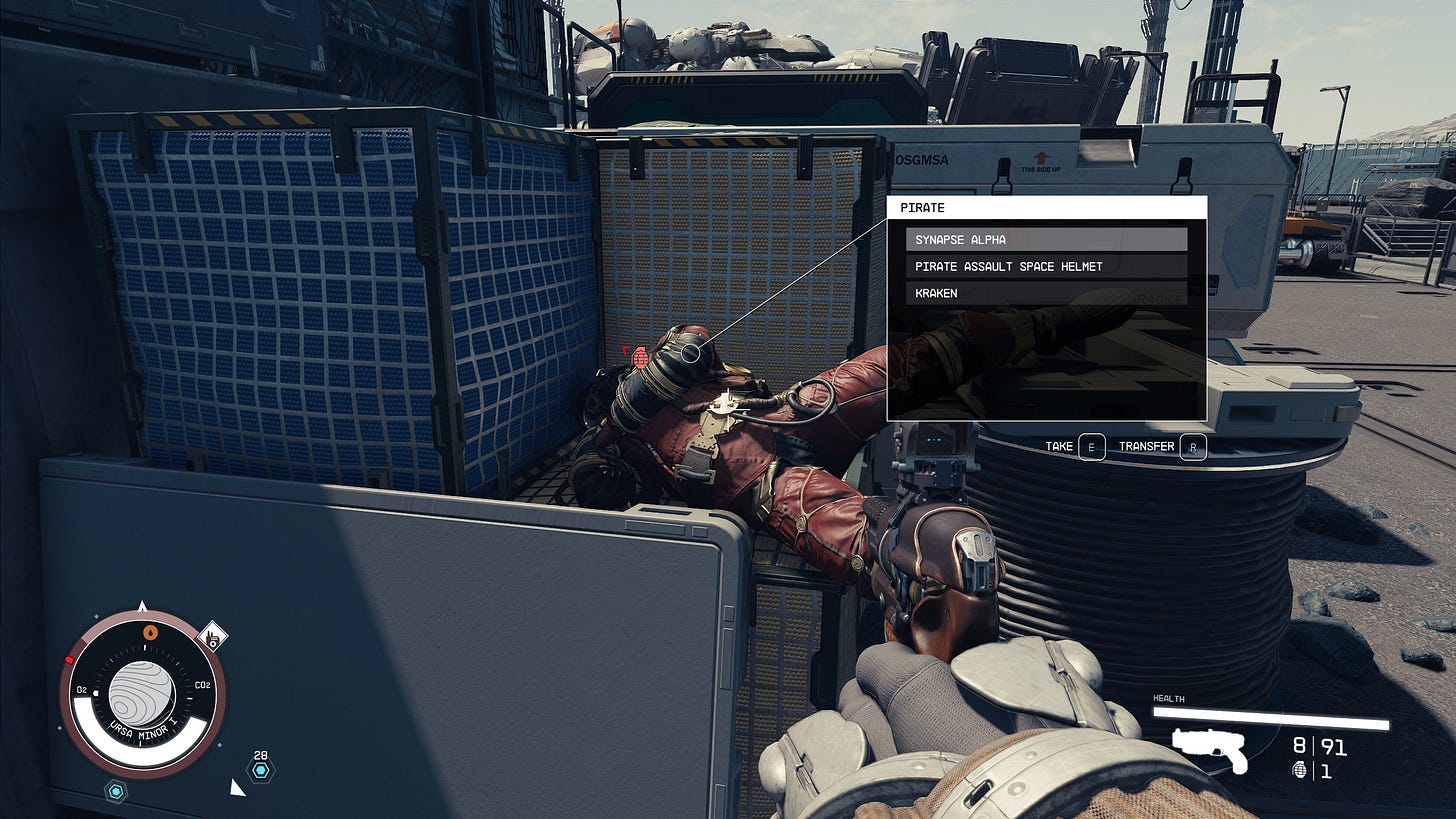
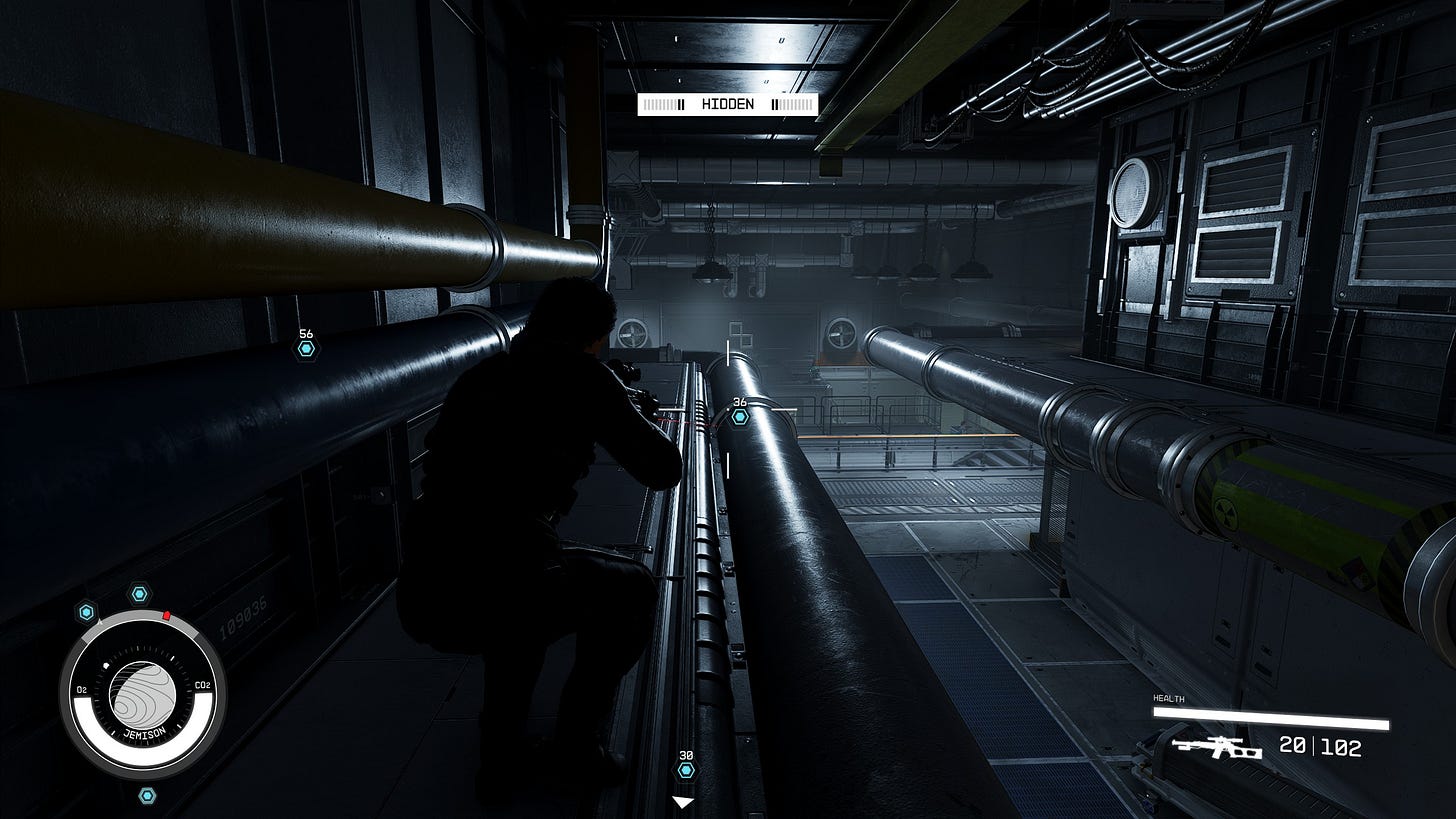
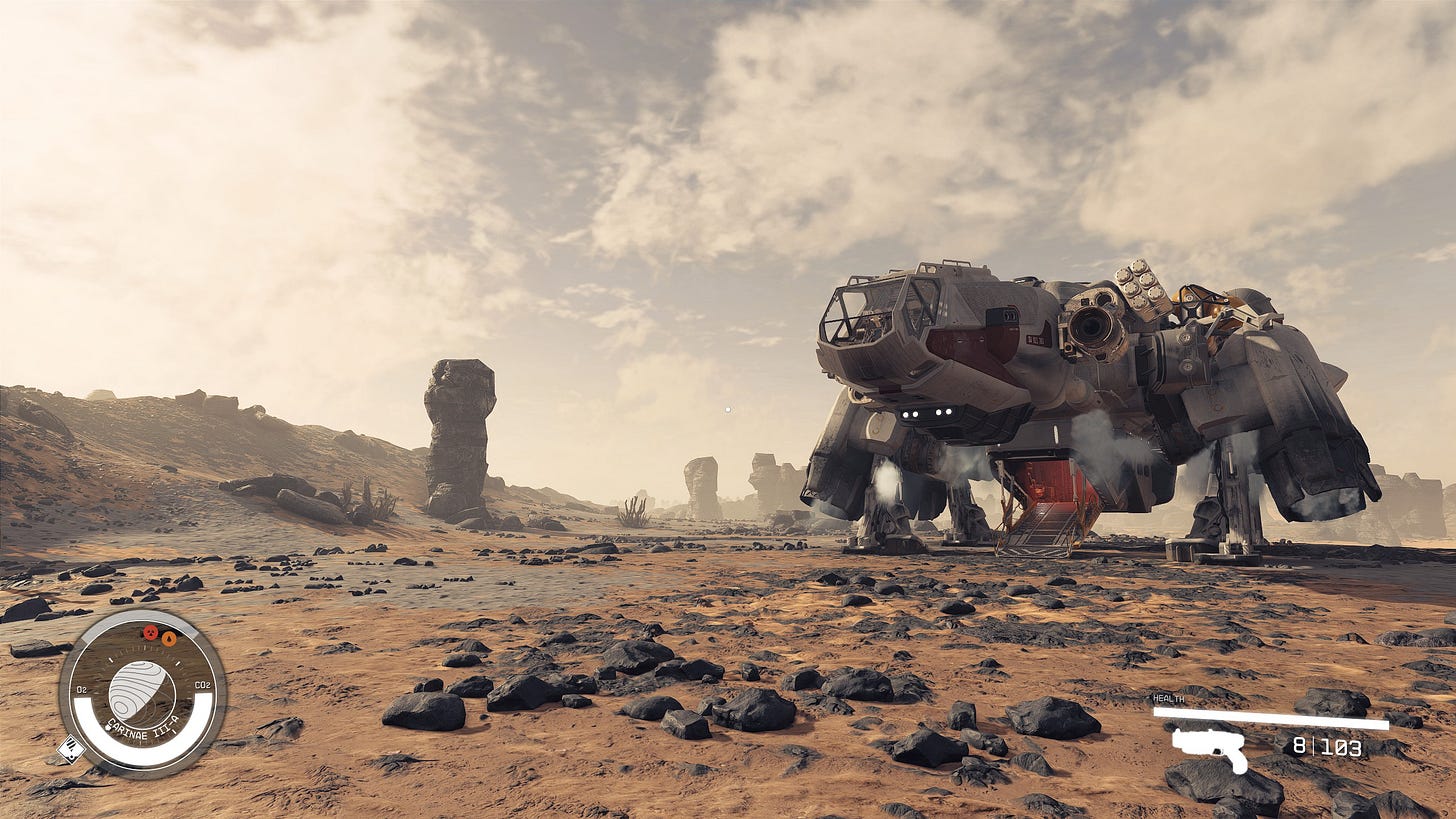
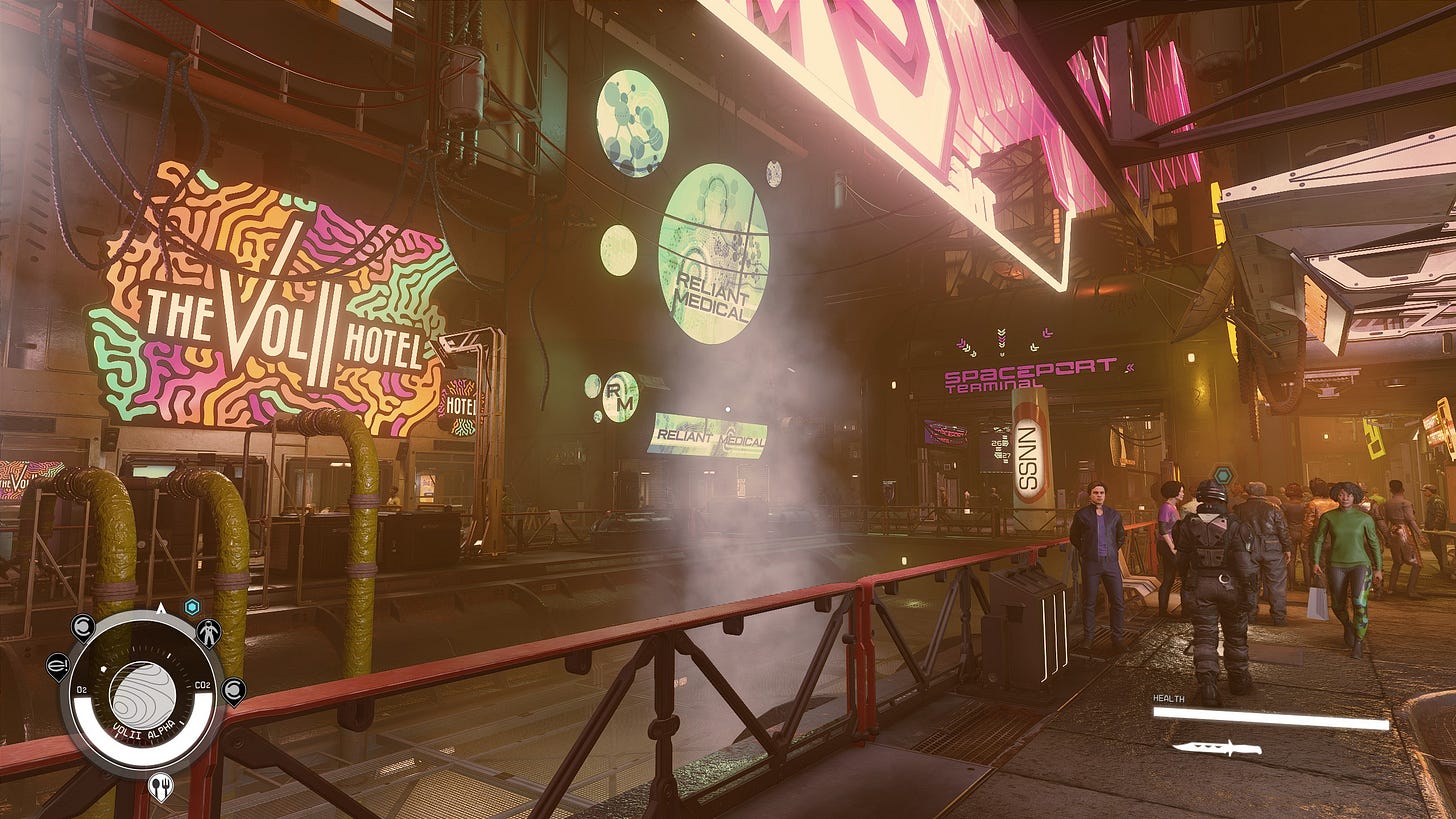



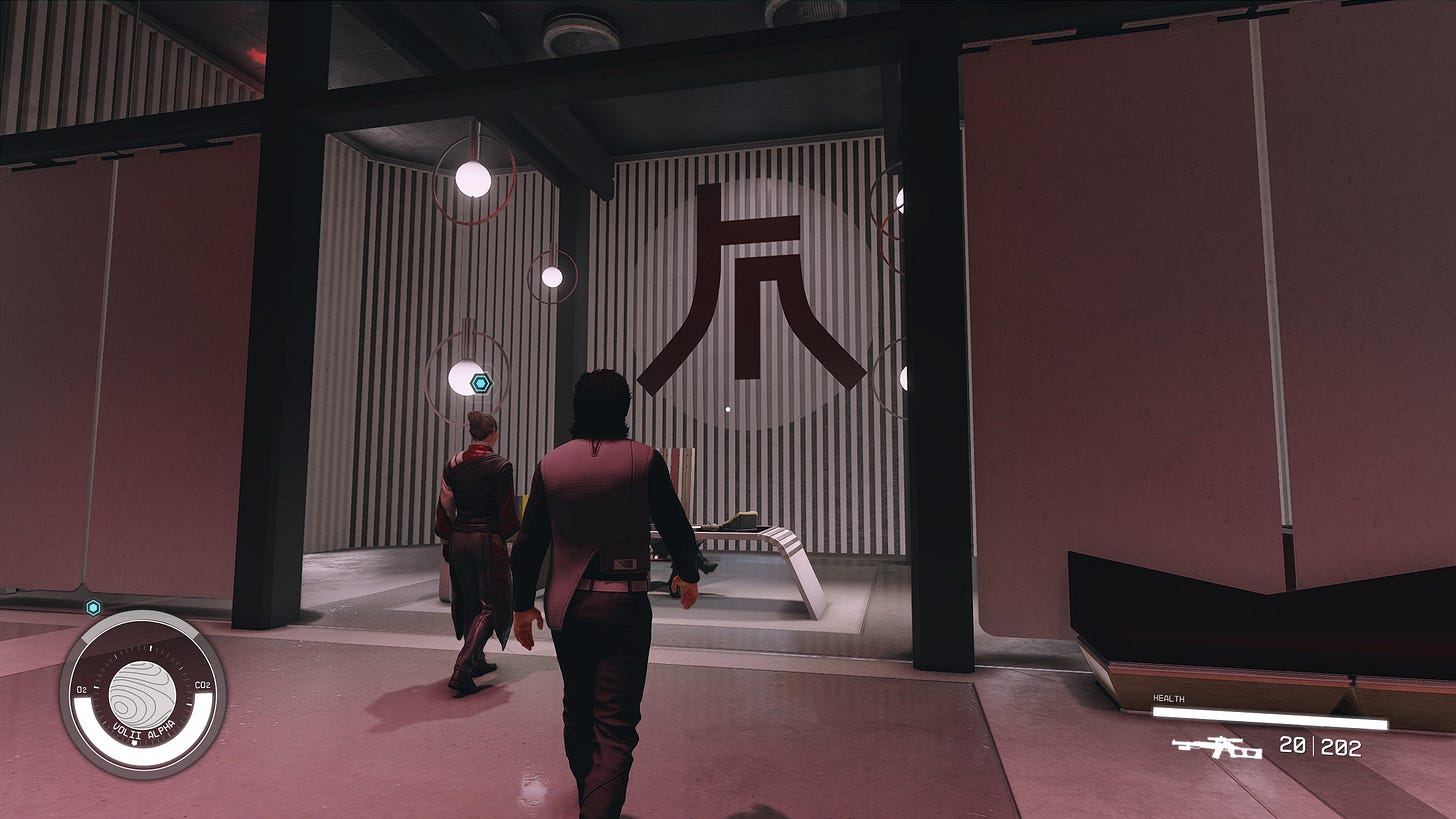
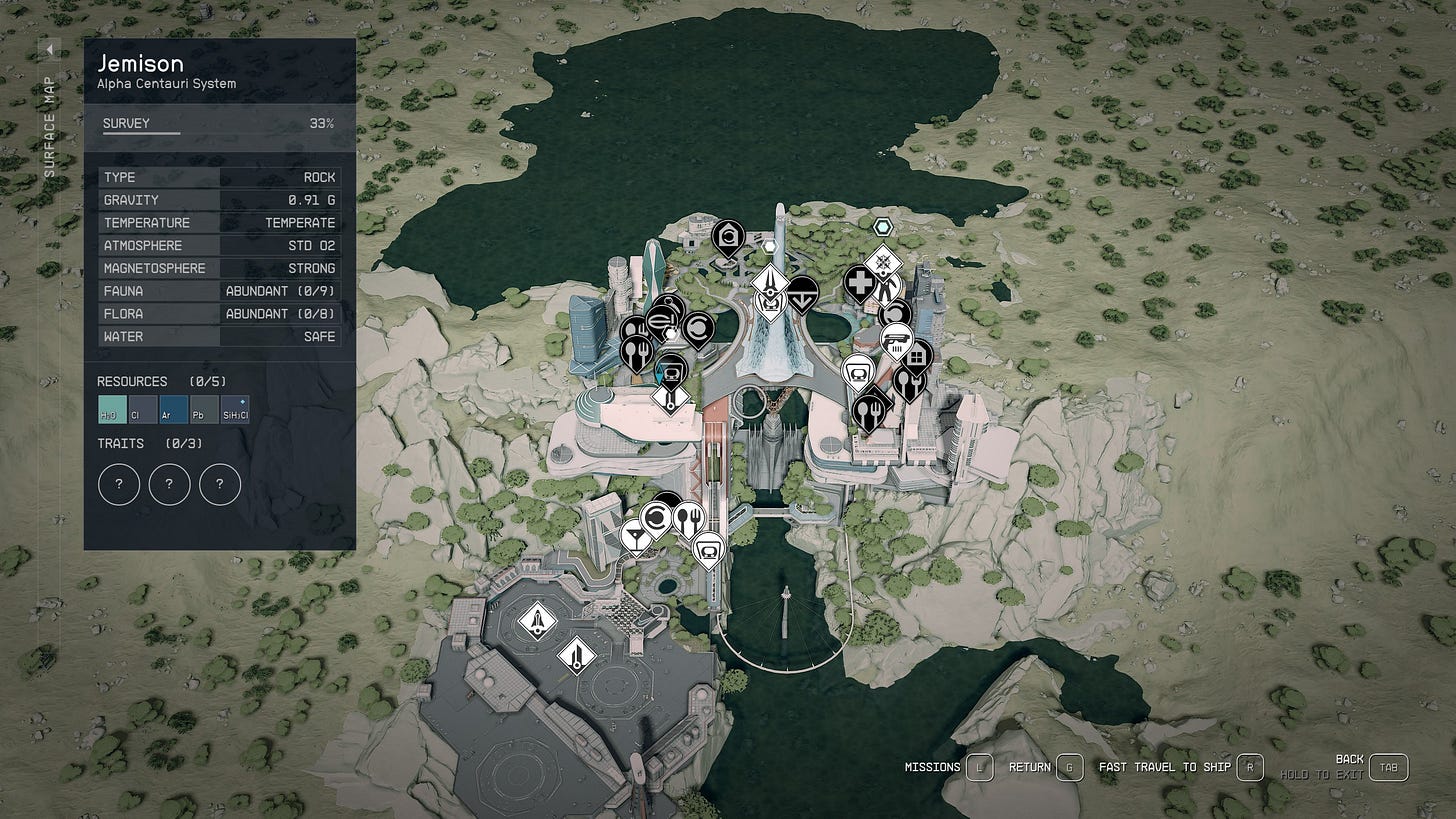

A very fair review of the game. I really wanted to like Starfield. I put a lot of time into the base building and ship building, spent a lot of time exploring, but I just didn't get that feeling of a living breathing world the way I did in other Bethesda games. It's hard to explain, but it's as if the game looks deep, but the more you play it, the shallower it feels. It's like I was in the Matrix in a world built for me, if that analogy makes sense. I might revisit it in a few years time, but it just didn't grab me.
Enjoyed this review. Haven't played Starfield. This makes me more curious. But probably not curious enough to actually play it when there are so many other games I haven't gotten around to playing that seem more interesting to me.
I partly disagree with this statement though:
>Fallout 4 really was the Starfield of its day and was widely rejected by Fallout fans
This doesn't sound right to me. I would say Fallout 4 was divisive. I think the median person who enjoyed Fallout 3 and NV was lukewarm on 4, considered it a disappointment but still had fun with it. I was in this camp (and I'm someone who's primarily a Fallout 1-2 fan at heart). Maybe 30-40% outright hated it. I also know people who loved 4 and consider it better than NV. These people mostly enjoy the settlement building aspect and tend to play with mods that expand that part of the game.
But Starfield doesn't seem divisive. Almost everyone seems to hate it, or to have no interest in it based on the hate. I don't personally know anyone who is a fan of it.